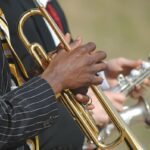Introduction
Music and dentistry might seem like distant realms, but for jazz musicians, the rhythm of their performances is intricately tied to the subtleties of oral health. Orthodontics, often associated with aesthetics, holds a remarkable impact on a jazz musician’s prowess. This article explores the symbiotic relationship between orthodontic treatments and the musical world of jazz, specifically emphasizing how the alignment of teeth and jaw plays a pivotal role in enhancing a musician’s performance. Delving beyond aesthetics, we uncover the profound influence of braces, Invisalign, and corrective treatments on breathing, embouchure, and overall comfort when playing wind instruments. Through insights, real-life testimonials, and expert perspectives, this discussion aims to highlight the instrumental role of orthodontics in fine-tuning a musician’s craft.
Impact of Teeth and Jaw Alignment on Musical Performance
Proper teeth and jaw alignment are paramount for wind instrument players, serving as the cornerstone for exceptional musical performance. In the realm of jazz, where precision and finesse are fundamental, the alignment of a musician’s teeth and jaw significantly influences their ability to play wind instruments with dexterity and ease.
Misalignments can create obstructions, hindering a musician’s capacity to produce optimal sound and impeding their technical abilities. Misalignment, whether minor or severe, can profoundly impact a musician’s performance. Improper teeth and jaw alignment can directly affect a jazz musician’s breathing patterns, embouchure (the positioning of the lips, tongue, and facial muscles while playing), and overall comfort during extended performances. This issue extends beyond mere discomfort, as it can substantially limit a musician’s capacity to play at their full potential.
Dental and musical experts alike acknowledge the undeniable correlation between oral health and musical proficiency. Research studies and expert opinions, such as those from the Canadian Dental Association and the Canadian Federation of Musicians, underline the significance of oral health in musical expression. They highlight how a healthy oral structure is not only vital for overall health but also a critical factor in a musician’s ability to achieve their desired level of artistry and musical expression. These insights illuminate the intricate relationship between dental alignment and the musical capabilities of jazz musicians, demonstrating the importance of oral health in their professional pursuits.
The Role of Orthodontic Treatments in Enhancing Performance
Orthodontic treatments, ranging from traditional braces to advanced solutions like Invisalign, play a pivotal role in harmonizing a jazz musician’s oral structure. In addressing dental misalignments, these treatments are orchestrated symphonies, working to correct issues that impede a musician’s performance. For instance, Langley orthodontists, who specialize in invisalign braces offer a spectrum of treatments tailored to align teeth and jaws specifically for enhanced musical prowess.
Both braces and Invisalign serve as instrumental tools in rectifying misalignments. Braces, comprising metal brackets and wires, gradually shift teeth into optimal positions, enhancing a musician’s ability to produce melodious notes. In contrast, Invisalign, a discreet and removable aligner system, provides similar corrective benefits without the visual impact of traditional braces, allowing musicians to maintain their stage presence.
Case Studies and Experiences
Before-and-after scenarios of jazz musicians undergoing orthodontic treatments reveal remarkable transformations. These case studies exemplify the tangible impact of such interventions on musical performance. Consider a scenario where a saxophonist struggled with embouchure control due to dental misalignment. Following orthodontic treatment, the musician displayed improved control and flexibility, evident in their nuanced playing style and enhanced tonal quality. These analyses demonstrate the direct correlation between orthodontic corrections and the musicians’ progress.
Personal Experiences
Several jazz musicians have openly shared their challenges resulting from dental misalignments and subsequent transformations post-treatment. Renowned trumpeter X, for instance, faced impediments in breath control and articulation due to misaligned teeth. After receiving orthodontic treatment, X reported a significant enhancement in both their playing comfort and technical abilities. These personal accounts underscore the transformative power of orthodontic treatments, not just in aesthetics but also in the profound enhancement of a musician’s instrumental skills and overall performance.
Expert Insights and Recommendations
Orthodontists and dentists specializing in musicians’ oral health offer invaluable insights into the nexus between orthodontics and musical performance. These professionals, like those at Langley Braces and Orthodontics, recognize the unique needs of musicians. They emphasize the significance of proper teeth and jaw alignment in optimizing a musician’s performance and recommend tailored treatments to rectify specific issues.
Tips and Advice
For musicians contemplating orthodontic treatments to elevate their musical performance, experts advocate a proactive approach. They advise thorough consultations to identify individualized treatment plans that address the specific challenges faced while playing wind instruments. Additionally, maintaining regular dental check-ups and adhering to proper oral hygiene practices are crucial for sustaining the benefits of orthodontic treatments.
Recommendations for Oral Health
Balancing a musical career with optimal oral health demands diligence. Experts suggest incorporating practices such as proper teeth cleaning, using mouthguards during performances to prevent injuries, and being mindful of the impact of playing on oral health. Additionally, integrating exercises that strengthen facial muscles and support oral posture can aid in sustaining improved performance post-orthodontic treatment. These recommendations serve as a holistic guide to harmonizing oral health and musical careers for jazz musicians.
Conclusion
In the melodious world of jazz, where every note resonates with emotion and precision, the significance of orthodontics in enhancing a musician’s performance cannot be overstated. The rhythm of jazz is intricately tied to the subtleties of oral health, and orthodontic treatments play a pivotal role in harmonizing a musician’s abilities. Through aligning teeth and jaws, these treatments orchestrate a symphony of improvements, optimizing breathing, embouchure, and overall comfort during performances. Real-life testimonials, expert insights, and transformative case studies collectively underline the profound impact of orthodontics on jazz musicians’ careers. By recognizing the symbiotic relationship between oral health and musical proficiency, this discussion underscores the instrumental role of orthodontics in fine-tuning a musician’s craft and ultimately elevating the jazz experience for both the performers and their audiences.



